Tomatoes are grown by more home growers than any other fruit or vegetable. I think homegrown tomatoes have a much better flavor than store-bought tomatoes. With so many people growing tomatoes, there are hundreds if not thousands of tomato fertilizers. You may be wondering, “What is the best tomato fertilizer?”
Picking a tomato fertilizer doesn’t have to be confusing. With my experiences, I have rounded up the best seven tomato fertilizers for every situation.
Here are my picks:
- Neptune’s Harvest | Tomato & Veg Fertilizer 2-4-2 – best liquid fertilizer for tomatoes
- Infinity Soil – Fish Bone Meal – best granular fertilizer for tomatoes
- Dr. Earth | Home Grown Tomato & Vegetable Fertilizer 4-6-3 – best organic fertilizer for tomatoes
- Jobe’s Tomato Fertilizer Spikes – best spike fertilizer for tomatoes
- Miracle-Gro Water Soluble Tomato Plant Food – best water-soluble fertilizer for tomatoes
- Miracle-Gro Performance Organics Edibles Plant Nutrition Granules – best budget
- Espoma Tomato-tone Organic Fertilizer – best overall
Why Fertilize Tomatoes?
Tomatoes need a lot of water and nutrients to develop the tasty fruit we eat, whether you are growing beefsteak, paste, or cherry tomatoes.
I have not found any soil that has all the nutrients a tomato plant needs to grow well and produce a lot of tomatoes. If you do not fertilize, you will not get very many tomatoes, and the ones you get will be smaller.
Why waste the time and space by not fertilizing?
How Do I Know If My Tomatoes Need Fertilizer?
Tomatoes need fertilizer when they are planted, when the first blooms begin, when the fruit is set, and then every two to four weeks after that.
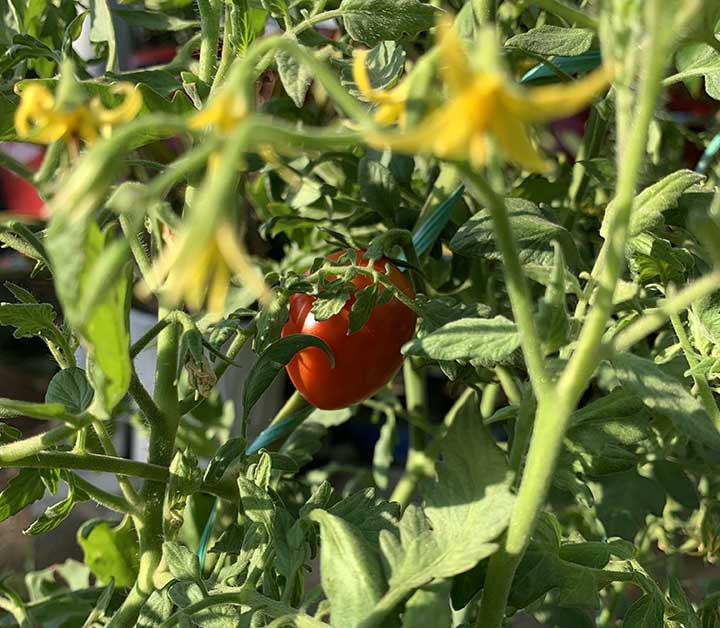
If I don’t fertilize my tomatoes, they grow poorly and do not have many blooms or tomatoes. The tomatoes the plants do have are smaller than tomatoes that get enough fertilizer.
In some cases, the leaves will be pale or yellow, depending on the nutrients that are missing. I find I need to fertilize more often in sandy soils and not as often in hard clay soils.
What Nutrients Do Tomatoes Need?
All plants, including tomatoes, need nitrogen, phosphorous, and potassium. These nutrients are the ones that the numbers on the fertilizer bag (the NPK ratio) refer to.
In addition, tomato plants need calcium, magnesium, and sulfur. Finally, tomato plants need iron, manganese, zinc, copper, boron, and molybdenum in small amounts. These are referred to as micronutrients or trace elements.
Major Nutrients
Nitrogen
Nitrogen is important for plant growth. Plants that do not get enough nitrogen will not grow well and are stunted. They also show yellowing lower leaves while the top leaves are a pale green.
Fewer new leaves grow, and the plant has few blooms. Too much nitrogen can cause a tomato plant to grow lots of foliage but no tomatoes.
In extreme cases, too much nitrogen will burn the plant roots and leaves and can even kill the plant.
Phosphorous
Phosphorous helps plants take other nutrients and use them. It is also important in causing blooms and setting fruit.
I apply a fertilizer with phosphorous in it when the plant starts blooming. Phosphorous deficiencies cause few or no blossoms, small plants, and weak roots. Too much phosphorous can burn or kill plants.
Potassium
Potassium helps plants move water, nutrients, and carbohydrates around the plant. It also helps plants grow more tomatoes and grow bigger tomatoes.
Potassium deficiencies cause the edges of the leaves to turn yellow. Too much potassium causes the plant to have problems absorbing nitrogen and phosphorous and can cause deficiencies in those nutrients even when they are present in the soil.
I make sure my tomato plants have plenty of potassium when they start fruiting.
Minor Nutrients
Calcium
Calcium helps your tomato plant form new roots and new root hairs. It is also used in the development of leaves. Without calcium, tomato plants can’t form and maintain healthy roots or put out new leaves.
Calcium also helps avoid blossom end rot, a disorder caused by too much water and not enough calcium.
Magnesium
Magnesium is an ingredient in chlorophyll. Chlorophyll converts water, nutrients, and sunlight into carbohydrates to give the tomato plant energy. If there is not enough magnesium, the plant can’t produce chlorophyll, and the leaves are pale.
Sulfur
Sulfur is part of the amino acids that make up proteins that the tomato plant needs to build every cell in its body. Sulfur also helps produce energy for the plant.
Trace Elements
- Iron – regulates and promotes growth.
- Manganese – helps with photosynthesis.
- Zinc – helps the stem and leaves grow.
- Copper – is important in forming plant enzymes.
- Boron – helps with the formation of cell walls. Too little boron also inhibits the uptake of calcium.
- Molybdenum – is needed for the tomato plant to form proteins from nitrogen. It also feeds the soil microbes.
Things to Consider When Choosing Tomato Fertilizers
When I choose a tomato fertilizer, I consider the following things:
- How expensive the fertilizer is?
- How long will a container last?
- What the fertilizer contains?
- What form the fertilizer takes?
- Is it organic?
I know concentrates are more expensive initially, but they save me money in the long run. Because concentrates do not need as many containers as ready-to-use liquids, they are a more environmentally friendly alternative.
Granular fertilizers typically last longer than liquid fertilizers. They release the nutrients slowly so are not as immediately available to the plant. You do not have to fertilize with granular fertilizers as often as with liquid fertilizers.
Best Fertilizers for Tomatoes
There are lots of different types of fertilizers for tomatoes. Here are my picks for the most common types.
1. Neptune’s Harvest Tomato & Veg Fertilizer 2-4-2 – Best Liquid Fertilizer for Tomatoes

Neptune’s Harvest | Tomato & Veg Fertilizer 2-4-2 is made of North Atlantic fish, molasses, yucca extract, seaweed, and humic acids. This fish fertilizer helps tomato plants grow strong roots and vines.
The fertilizer also helps the plant bloom and grow great tomatoes. I have found that healthy plants tolerate drought and pests better and do not get as many diseases.
Because this is a liquid, my tomatoes take Neptune’s Harvest | Tomato & Veg Fertilizer 2-4-2 up very quickly and turn a brighter green a few days after I apply it.
Because it has phosphorous and potassium in addition to nitrogen, I can use Neptune’s Harvest | Tomato & Veg Fertilizer 2-4-2 all season long if I want. The fertilizer is a little pricey, but the 32-ounce bottle makes 32 gallons of fertilizer.
How to apply?
I mix one ounce of the concentrate with a gallon of water. Then, I water the area around the tomatoes until the soil is saturated. Mix only as much fertilizer as you need because it becomes smelly if stored as a mixed solution. I use it every two weeks. Neptune’s Harvest | Tomato & Veg Fertilizer 2-4-2 may be too strong for seedlings, so mix it at ½ ounce per gallon of water when fertilizing them.
Pros:
- Good for all growth stages.
- High-quality ingredients.
- Easily taken up by tomato vines.
Cons:
- Pricey
- Must be mixed
- Not certified organic
2. Infinity Soil – Fish Bone Meal – Best Granular Fertilizer for Tomatoes

Infinity Soil – Fish Bone Meal is a 4-17-0 fertilizer made from the bones of marine fish caught for human consumption.
I like using a product made from something that would otherwise go to waste.
This fertilizer has nitrogen, phosphorous, and calcium. Calcium is really important for avoiding blossom end rot in tomatoes. In my opinion, this fertilizer is the best calcium fertilizer.
The granules release their nutrients gradually, so Infinity Soil – Fish Bone Meal is one I spread around my tomato bed before planting my seedlings. The cost is very reasonable.
How to apply?
I spread two tablespoons per square foot in my garden. After the transplants grow their vines and are ready to bloom, I spread four tablespoons per square foot around my tomatoes. I water my tomatoes well after spreading the bone meal around.
You only have to spread this fertilizer every four weeks.
Pros:
- Promotes growth and blooms
- Helps prevent blossom end rot
- Easy to use
- Reasonably priced
Cons:
- Not certified organic
- Contains no potassium
3. Dr. Earth | Home Grown Tomato & Vegetable Fertilizer 4-6-3 – Best Organic Fertilizer for Tomatoes

Dr. Earth | Home Grown Tomato & Vegetable Fertilizer 4-6-3 is a blend of wild-caught Alaskan fishbone and meal, feather meal, kelp meal, alfalfa meal, soft rock phosphate, mined potassium sulfate, humic acid, and seaweed extract.
Dr. Earth includes their TruBiotic® which is an inoculant containing beneficial soil microbes and mycorrhizae. These organisms help your tomato plant use the nutrients contained in the fertilizer better.
The fertilizer does not contain any GMO products, chicken manure, or synthetic ingredients and is certified organic.
I always prefer organic ingredients, personally. Even better, Dr. Earth makes this fertilizer in the U.S.A. from sustainably sourced ingredients.
The fertilizer can be used as granules spread around your transplants or mixed with water and applied as a liquid. This four-pound bag of fertilizer will fertilize 60 square feet or 16 five-gallon containers.
How to apply?
I find the granules great to spread around my vegetable bed before transplanting my seedlings. I spread 1 1/3 cups per ten feet of row. For my container plants, I use ½ cup per five-gallon container. This one application lasts until the tomato plants start having tomatoes.
Pros:
- Use as granules or liquid
- Easy to use
- Organic
- Made in the U.S.A.
- Made from sustainably sourced ingredients
- Has beneficial soil microbes and mycorrhizae
- Inexpensive
Cons:
- Strong, unpleasant smell, especially when mixed with water
4. Jobe’s Tomato Fertilizer Spikes – Best Spike Fertilizer for Tomatoes

Jobe’s Tomato Fertilizer Spikes are an easy-to-use type of fertilizer. The NPK ratio is 6-18-6, so you can use the spikes all season long. I like not having to mix the fertilizer or store a large package of leftovers. One package has eighteen spikes and is very inexpensive.
I especially like being able to put one spike in a container and not worry about fertilizing again for eight weeks. Containers need more fertilizer than plants in the ground, and I get tired of reapplying fertilizer every two to four weeks.
Because the spikes go into the ground, they do not wash away as easily as granular fertilizers. The spikes do not smell while they are in the ground, either. Sometimes, if the package is handled roughly in transit, the spikes arrive broken or crumbled.
How to apply?
I simply insert one Jobe’s Tomato Fertilizer Spike per tomato plant in the ground or in a five-gallon pot. I have found the best results by placing the spike three to six inches from the plant. The spike lasts eight weeks.
Pros:
- No bad odor
- It lasts a long time
- Go for all growth stages
- Inexpensive
- Do not wash away as easily as granules
- Easy to use
Cons:
- Spikes may be broken or crumbled in the package
- Not organic
5. Miracle-Gro Water-Soluble Tomato Plant Food – Best Water-Soluble Fertilize for Tomatoes

Miracle-Gro Water Soluble Tomato Plant Food has an NPK ratio of 18-18-21. It also has magnesium, manganese, zinc, copper, and iron. It does not have calcium in it.
I like that the blend of macro and micronutrients feeds your tomatoes what they need to grow healthy plants with lots of juicy tomatoes. Miracle-Gro Water Soluble Tomato Plant Food is guaranteed not to burn your plants if you mix it as directed.
This fertilizer is inexpensive and covers a lot of tomato plants when mixed as directed. I can spend more money on plants and less on fertilizer.
Because this fertilizer dissolves in water, Miracle-Gro Water Soluble Tomato Plant Food is immediately available to plants. I can tell a difference within a few days of fertilizing my tomatoes.
Because this fertilizer is water soluble, it is great to use in hydroponic systems.
How to apply?
I mix 1 ½ tablespoons into 1 ½ gallons of water and use it to water my tomatoes once every seven to fourteen days. How often I use it depends on the tomato’s growth stage and how the plants look.
Pros:
- Inexpensive
- Won’t burn my plants
- Water soluble
- It has some needed micronutrients
Cons:
- Does not contain all the micronutrients
- Does not have calcium
- Not organic
- Must be reapplied frequently
6. Miracle-Gro Performance Organics Edibles Plant Nutrition Granules – Best Budget Fertilizer for Tomatoes
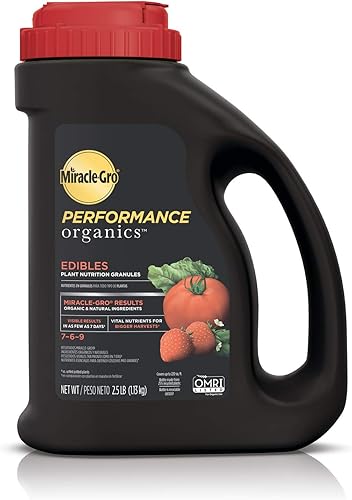
Miracle-Gro Performance Organics Edibles Plant Nutrition Granules have an NPK ratio of 7-6-9, making it a great fertilizer to use all season long. It also has calcium, magnesium, and sulfur.
I like that this fertilizer is organic, so I feel comfortable using it on my edibles. This fertilizer is very inexpensive but still delivers the nutrients my tomatoes need. I also find Miracle-Gro Performance Organics Edibles Plant Nutrition Granules don’t have a bad odor.
I like that Miracle-Gro Performance Organics Edibles Plant Nutrition Granules are easy to use. I just scatter the granules around my tomato plants without having to mix anything.
I don’t have to fertilize again for four to six weeks, depending on how my tomato plants are doing. I can start seeing improvements in the health and growth of my tomato plants as soon as seven days after using Miracle-Gro Performance Organics Edibles Plant Nutrition Granules.
How to apply?
I sprinkle up to one cup of Miracle-Gro Performance Organics Edibles Plant Nutrition Granules per 25 square feet.
In a container, I mix two tablespoons per gallon container. I like to mix it in the top one to two inches of the soil, then water it well. Make sure you do not let the fertilizer touch the tomato plant.
I apply Miracle-Gro Performance Organics Edibles Plant Nutrition Granules every four to six weeks.
Pros:
- Good pick for use on a budget
- Organic
- Good all season long
- It can be used on other vegetables
- Has calcium
- Easy to use, no mixing
Cons:
- Doesn’t have all the micronutrients my plants need
7. Espoma Tomato-tone Organic Fertilizer – Best Overall Fertilizer for Tomatoes

Espoma Tomato-tone Organic Fertilizer has an NPK ratio of 3-4-6 with eight percent calcium to combat blossom end rot. Espoma’s propriety Bio-tone is a blend of beneficial microbes and food for the soil microbes, so they can help my tomato plants digest the other nutrients it contains.
Espoma has been making organic fertilizers since 1929 and really knows what they are doing. I really like Espoma products. I don’t have to worry about toxic sludge, hazardous ingredients, or anything but growing tomatoes.
I don’t have to worry about my tomato plant growing lots of vines and leaves but not having blossoms and tomatoes when I use Espoma Tomato-tone Organic Fertilizer.
How to apply?
To use, I take one cup of fertilizer per five feet of row and spread it on one side of my tomato plants, at least three inches from the vines. I spread the same amount of fertilizer on the other side of the tomato plants.
After I apply Espoma Tomato-tone Organic Fertilizer, I water my tomato plants well to make the fertilizer available to them. I use the fertilizer every two weeks. That sounds like a lot of fertilizer, but my plants really love Espoma Tomato-tone Organic Fertilizer.
For containers, I use 1.4 teaspoons per one four inches of pot diameter. Sprinkle it along the inner edge of the pot and water the plant well.
Pros:
- Organic
- Easy to use
- Inexpensive
- Has beneficial soil microbes in it
- From a reputable company
- No sewage sludge
Cons:
- Use a lot of fertilizer
- Doesn’t contain all the micronutrients
When & How to Fertilize Tomato Plants?
Tomatoes are considered heavy feeders. It takes a lot of nutrients and water to make lots of big tomatoes.
Seedlings
I like to grow tomatoes from seed. When the seedlings have their first two true leaves, I start fertilizing them every two weeks with a liquid fertilizer.
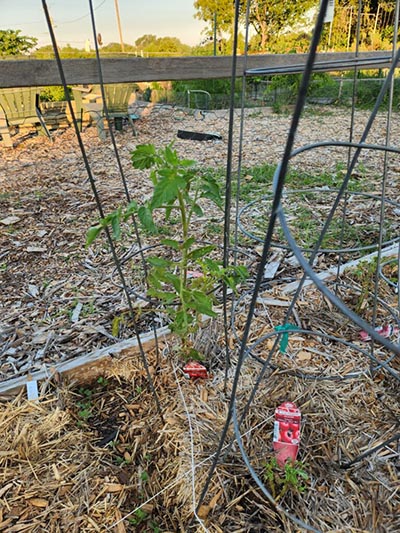
Transplants
When the young tomato plants are ready to plant in the ground, I spread a balanced fertilizer such as a 10-10-10 over the area I am putting my tomatoes in. I water the area to make the fertilizer available to my transplants as soon as I plant them. If you don’t water your transplants in, they will dehydrate and die.
Blossoming
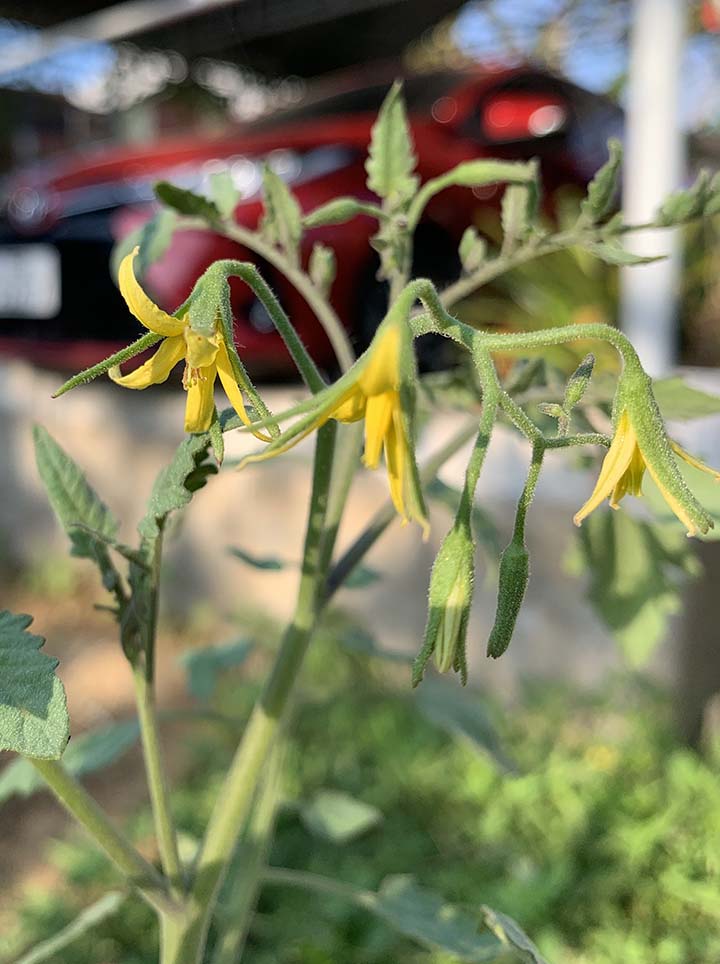
When my tomatoes start to blossom, I make sure they have plenty of phosphorus and reduce the nitrogen I give them. Too much nitrogen now will reduce the number of blooms and cause the vines and leaves to grow too much.
Fruit Set
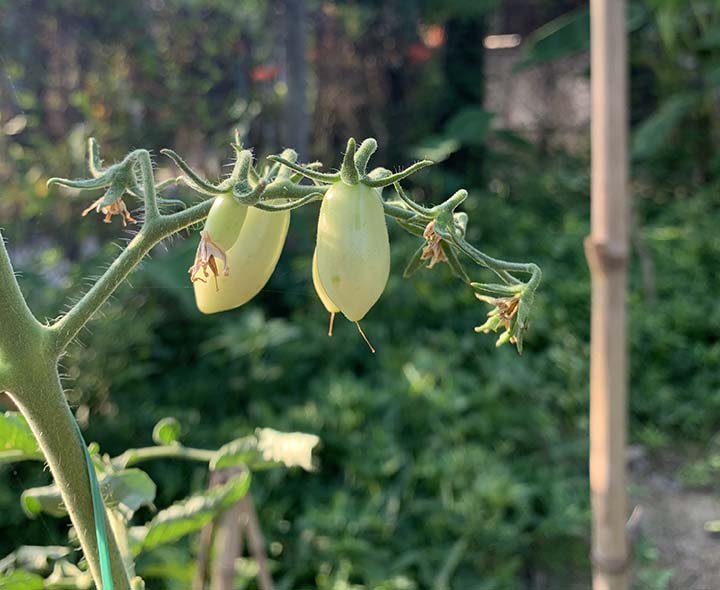
When the first tomatoes are an inch in diameter, I fertilize the tomato plants again. I spread fertilizer around the plants, being careful not to let the fertilizer touch the plants.
Ongoing Fertilization

Every two to four weeks after the tomatoes are an inch in diameter until the plants stop bearing tomatoes, I spread fertilizer around the plants.
Organic versus Synthetic Fertilizers
Organic fertilizer is made only from things found in nature. The USDA and other organizations certify a fertilizer as organic if it meets the strict requirements for certification. Natural fertilizer is not the same as organic. Natural fertilizer is not a regulated term, so anyone can claim their fertilizer is natural.
Synthetic fertilizer is made in a lab. It may contain some things from nature, but most of it is from chemicals mixed in a lab. Many synthetic fertilizers are derived from petroleum products. Some people feel synthetic fertilizers kill the microbes in the soil.
I prefer organic fertilizers, so my picks for tomato fertilizers are organic where possible.
Types of Fertilizers
Fertilizers come in one of four types: granules, water-soluble granules or powders, spikes, and liquids.
Granular Fertilizers
Granular fertilizers do not require mixing and slowly release their nutrients. I put out granular fertilizers when I plant my transplants outside so they can get a head start on growing big vines. Granule fertilizers may take a while to release enough fertilizer to feed your plants, especially if the soil stays dry.
Liquid fertilizers
Liquid fertilizers are either concentrates that require mixing or ready-to-use products. I prefer concentrates. Liquid fertilizers are available to tomato vines immediately. However, they have to be used more often than granular fertilizers.
Water soluble fertilizers
Water soluble granules or powders dissolve in water so you can pour the solution around your plants. You can also sprinkle the fertilizer around your plants and water them. This type of fertilizer is immediately available to your plants. Water soluble fertilizer can leach out of the soil when you water your plants, especially in sandy soil.
Spike fertilizers
Spikes are granular fertilizers formed into spikes. These fertilizers are stuck in the ground three to six inches from each tomato plant. The spikes release their fertilizer over about eight weeks, so they are an easy type of fertilizer to use. Like granular fertilizers, the spikes may take a while to release enough fertilizer for your plants to use.
Homemade versus Commercial Fertilizers
Some people like to make their own fertilizer, so they know exactly what it contains. Others prefer to purchase a commercial fertilizer because it is easier. If you want to make your own fertilizer, read my article Homemade Tomato Fertilizer for recipes.
When Do I Stop Fertilizing Tomatoes?
Do not stop fertilizing your tomato vines until they stop producing tomatoes.
Signs You Are Over-Fertilizing Your Tomatoes
Over-fertilization is as bad as not fertilizing enough. Here are some signs you are using too much fertilizer.
- If your tomato plants are growing and growing but never seem to bloom or have tomatoes, you have probably used too much nitrogen fertilizer. Switch to a low nitrogen fertilizer that is high in phosphorous to trigger blooms.
- If your plant turns brown on the edges of the leaves the day or a few days after you spread fertilizer, you have used too much. Water around the tomato plant with lots of water to flush the excess fertilizer out of the soil.
- If you have a crusty layer on the surface of the soil around your tomatoes, you are not using enough water when fertilizing your tomatoes with a granular fertilizer. You will need to flush the crust away with lots of water to keep the tomato plants from being poisoned. In the future, make sure you water granules in with more water.
- Yellow lower leaves can be a sign of many things. One of those things is too much fertilizer. Excess nitrogen can make it hard for the tomato plants to absorb enough water, causing premature yellowing of the lower leaves. Reduce the amount of nitrogen you are feeding your tomatoes and see if that helps.
Fertilizing Tomatoes in Difference Locations
Tomatoes grown in containers, whether indoors, outdoors, or in a greenhouse, will need more frequent fertilization than tomatoes grown in the ground. The nutrients in a container are used up more quickly because they are limited to the soil in the container.
In raised beds or traditional beds, tomatoes have a larger area of soil to draw nutrients from. Tomatoes in pots cannot grow and produce tomatoes without regular fertilizer. If you miss fertilizing tomatoes in the ground, it will slow the growth of the vine and result in fewer tomatoes but won’t usually stop tomato production.
Do Difference Types of Tomatoes Matter?
Determinate tomatoes like Roma tomatoes have all their tomatoes at once.
Indeterminate tomatoes like Brandywine tomatoes have them over several weeks or months.
You won’t use as much fertilizer with determinate tomatoes because the vines do not produce as long. Other than that, there is no difference in when you fertilize your determinate or indeterminate tomatoes.
Caring For Your Tomatoes Throughout Their Lifecycle
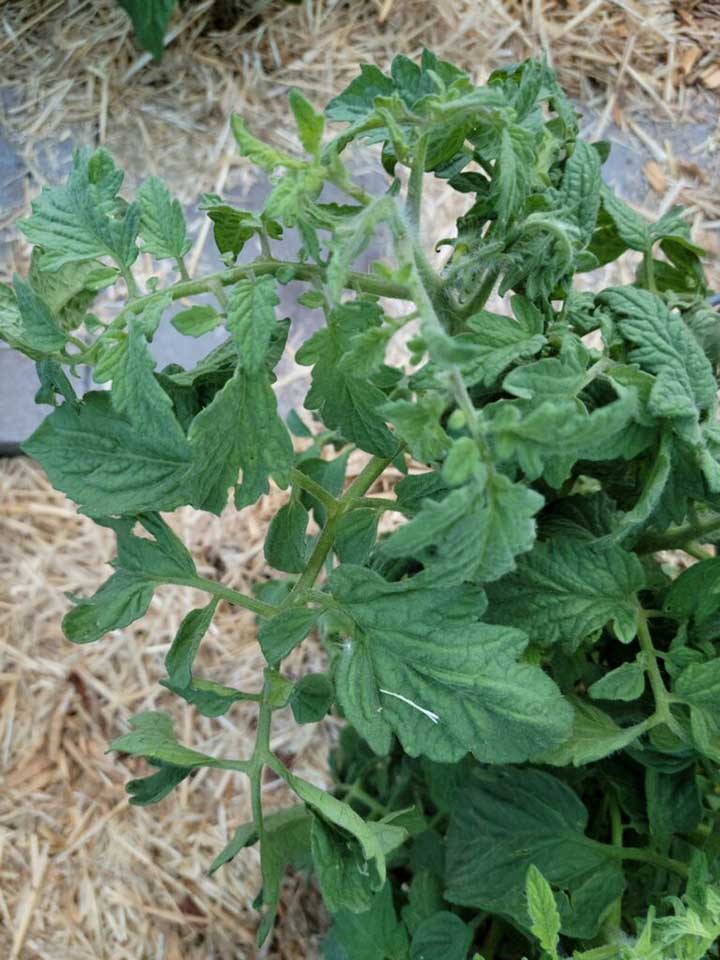
Tomatoes need other things in addition to fertilizer. Healthy plants produce more tomatoes and are resistant to pests and diseases. Here are some tips I have used to grow the biggest, juiciest tomatoes.
- Plant your tomatoes where they can get at least six hours of sunlight a day.
- If you live in a hot climate, afternoon shade or shade cloth will help keep your tomatoes from getting sunburned.
- Make sure your soil drains well and is rich in organic matter. Work three inches of compost into the top six inches of soil before planting your tomatoes in the garden.
- Make sure you do not use manure on your tomatoes because it may contain diseases and weed seeds.
- Water your tomatoes at least an inch a week. I have found it best to divide that into two waterings a week because it is very hot where I live. Otherwise, water all at once to help develop deep roots on the plant.
- Too much water can cause blossom end rot and root rot. The soil should be moist but not wet. A moisture meter is cheap insurance against problems caused by overwatering or underwatering.
- Buy the best fertilizer you can afford. Cheap fertilizers contain cheaper ingredients that are not as available to your plants. Some of them also contain sewage sludge.
- Mulch around your tomato plants to help keep the soil at a more stable temperature, hold moisture, and keep weeds down.
- Keep weeds away from your tomatoes. Weeds steal sunlight, water, and nutrients and can crowd out your tomato plants.
- Don’t plant your tomato plants until all danger of frost has passed. It is tempting to plant too early in the spring, but frost damages the tomato plant, and it will never grow as well or have as many tomatoes as plants that are not hit by frost.
- Do not get water on the leaves of the tomato plants. I have found this spreads diseases and causes a lot of problems for my tomato plants.
- Use tomato plants that are resistant to the diseases in your area. If you want to grow heirloom tomatoes, consider using grafted tomatoes to get disease-resistant rootstock and heirloom tomatoes.
- Inspect your tomatoes every day. The faster you detect a problem, the faster you can solve it.
Final Verdict
There are lots of factors that go into choosing the best tomato fertilizer. Your soil, whether the tomato is in the ground or in a pot, and how often you are willing to fertilize should all be considered.
For me, the Espoma Tomato-tone Organic Fertilizer is the best tomato fertilizer. It is organic, and from a company I trust. However, any of the fertilizers mentioned in this article will help you grow wonderful, juicy tomatoes that beat store-bought tomatoes by a mile.

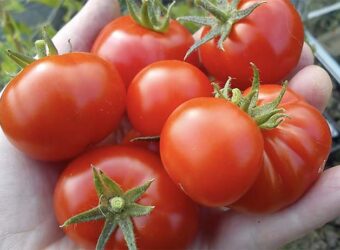





This information is not correct. “Do Difference Types of Tomatoes Matter?
Determinate tomatoes like San Marzano tomatoes have all their tomatoes at once.
Indeterminate tomatoes like Brandywine tomatoes have them over several weeks or months”.
San Marzano are indeterminate. Thank you.
You are correct. Even though San Marzano tomatoes are used for paste and canned, they are indeterminate. I have made the change in the article.
Nice and informative article. Just one little question. I could not see anything on the packaging of Jobe’s Fertilizer Spikes (for tomatoes) that indicated they are organic. You listed “organic” as one of the PROs for this product. Assuming it is not an error on your part, if you know something beyond the labeling that indicates it is organic, please share. Thank you in advance!
Good catch. It should have been listed as not organic in the cons. I have updated the article.